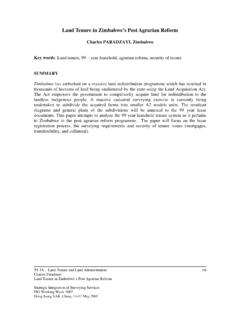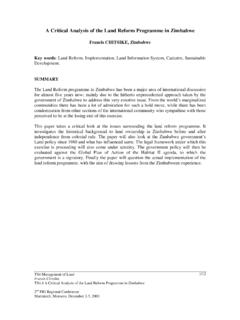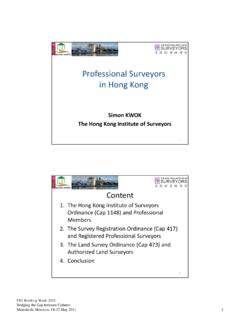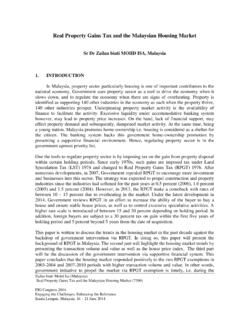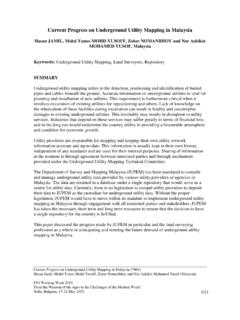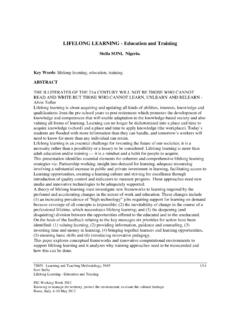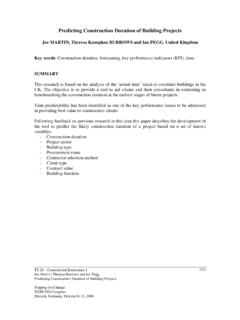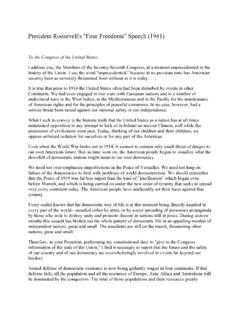Transcription of The Causes and Consequences of the Informal Settlements in ...
1 TS 35 - Informal Settlements : Policy, Land Use and Tenure 1/17 Mohammed Haji Ali and Muhammad Salim Sulaiman The Causes and Consequences of the Informal Settlements in Zanzibar Shaping the Change XXIII FIG congress munich , Germany, October 8 13, 2006 The Causes and Consequences of the Informal Settlements in Zanzibar Mohammed Haji ALI and Muhammad Salim SULAIMAN, Tanzania Key words: Informal settlement, urbanization, land, environment and poverty SUMMARY Despite having a long history of physical planning, Zanzibar has been experiencing increasing problems associated with the Informal Settlements (IS).
2 According to a recent study, over 70 per cent of urban residents live in Informal Settlements (GoZ 2005). A vast majority of the dwellers live in extremely poor conditions. A rapid increase in the urban population and the limited capacity of the government to meet the high demand for building plots has led to mushrooming of the Informal Settlements (Scholz 2006). Urbanization is one of the root Causes for the spread of Informal Settlements on the fringe of Zanzibar town. The land administration and planning policies, which have often been seen as rigid and inadequate to meet ever increasing demand for housing by the poor majority, have also been associated with the mushrooming of the IS.
3 The growth of the IS has resulted in many, and complex socio-economic and environmental Consequences . These include pollution, deforestation, flooding, waste of agricultural lands and the like. TS 35 - Informal Settlements : Policy, Land Use and Tenure 2/17 Mohammed Haji Ali and Muhammad Salim Sulaiman The Causes and Consequences of the Informal Settlements in Zanzibar Shaping the Change XXIII FIG congress munich , Germany, October 8 13, 2006 The Causes and Consequences of the Informal Settlements in Zanzibar Mohammed Haji ALI and Muhammad Salim SULAIMAN, Tanzania 1.
4 INTRODUCTION Informal settlement (also referred to as a shanty town or squatter settlement) has been defined in various ways depending on the planning and legal framework of a country where it exists. For the purposes of this discussion, Informal Settlements are defined as residential buildings built on planned and unplanned areas which do not have formal planning approval. They are characterized mostly by the low quality houses and the lack of, or inadequate infrastructure and social services.
5 Informal Settlement (IS) has been perceived both as a problem and solution to housing needs in speedily growing cities of many developing countries. (Srivinas 2005, Todaro 1994). Like many developing countries, Zanzibar (which is part of the United Republic of Tanzania) has been experiencing the demographic phenomenon of urbanization which is one of the driving forces for the mushrooming of Informal Settlements on the fringe of urban centres. Recent studies and surveys show that about 70 per cent (272,106) of the urban population in Zanzibar live in Informal Settlements (GoZ 2005, Azzan et al 2005).
6 Growth of these unplanned Settlements has been associated with many land and environmental related problems. 2. BACKGROUND Pre-Revolution Era For a long time, IS, as it is defined today, has been in existence in Zanzibar but was not considered by the authority as illegal. As Srinivas (2005) cognately argues, the term Informal /squatter settlement is in fact a more recent western-initiated development, which particularly came about during and immediately after the Habitat Conference of 1976 in Vancouver, Canada.
7 The rapid expansion of trade and other economic opportunities during the early nineteenth century resulted in the booming growth of the population and the town of Zanzibar itself. It was during this period when Ng ambo (or the other side) of Zanzibar Town started to grow and residential areas like Vikokotoni, Kikwajuni, Mwembetanga, etc were established. During Ng ambo s first seventy years of settlement ( 1920), residents were allowed to do just as they liked in most matters of architecture, design and development; Christie in Myers (1999).
8 By the turn of 20th century over 50 per cent of TS 35 - Informal Settlements : Policy, Land Use and Tenure 3/17 Mohammed Haji Ali and Muhammad Salim Sulaiman The Causes and Consequences of the Informal Settlements in Zanzibar Shaping the Change XXIII FIG congress munich , Germany, October 8 13, 2006 land in Zanzibar was under Wakf1 (Fair 2001). This gave room for poor people from Tanganyika and rural areas to build their houses on these more or less free lands without any planning regulation.
9 In 1923, the colonial government commissioned a study on issues related to housing in Zanzibar. The study described the existing situation in Ng ambo as .. passing over the creek to the other half of the town area, ..occupied by Swahili huts, many of which are irregularly scattered, while even in the more closely built quarters no systematic scheme of roads has ever been laid down, and the huts are packed along irregular and narrow lanes (Lanchester 1923:13).
10 The study produced a plan which recommended better types of houses and a system of waste management and sanitation in Swahili (native) areas which were considered to be a great health risk. The Lanchester Plan was followed by the first planning law; the Town and Country Planning Decree, Cap. 85 of 1955, which is still in use today. This is a comprehensive piece of legislation which devolves substantial powers to the local authorities. It provides guidelines for planning and use of land and its control, and makes provision for the orderly and progressive development of lands in urban and rural areas (TCP 1955).
